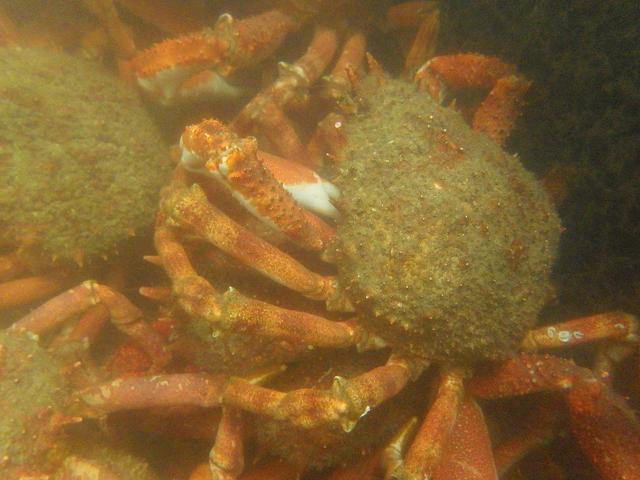
APHOTOMARINE
An educational resource dedicated mainly to the photography
and diversity of marine life that can be found in coastal waters
and intertidal areas of Great Britain and Ireland by David Fenwick.

Maja brachydactyla Balss, 1922 - Common / Prickly spider crab or Corwich crab
Scroll down and rollover titles to change screen image or click on title to view image.
Common or Prickly spider crab
Maja brachydactyla
- in commercial holding tank 1
Maja brachydactyla
- in commercial holding tank 1
Common or Prickly spider crab
Maja brachydactyla
- in commercial holding tank 2
Common or Prickly spider crab
Maja brachydactyla
- berried female / top view 1
Common or Prickly spider crab
Maja brachydactyla
- berried female / top view 2
Common or Prickly spider crab
Maja brachydactyla
- berried female / top view 3
Common or Prickly spider crab
Maja brachydactyla
- berried female / underside 1
Common or Prickly spider crab
Maja brachydactyla
- berried female / underside 2
Common or Prickly spider crab
Maja brachydactyla
- female with eggs 1
Common or Prickly spider crab
Maja brachydactyla
- eggs 1
Common or Prickly spider crab
Maja brachydactyla
- eggs 2
Common or Prickly spider crab
Maja brachydactyla
- eggs 3
Common or Prickly spider crab
Maja brachydactyla
- eggs 4
Common or Prickly spider crab
Maja brachydactyla
- eggs 5
Common or Prickly spider crab
Maja brachydactyla
- live underwater 1
Common or Prickly spider crab
Maja brachydactyla
- dead claw / knipper 1
Common or Prickly spider crab
Maja brachydactyla
- dead claw / knipper 2
Common or Prickly spider crab
Maja brachydactyla
- dead claw / knipper 3
Common or Prickly spider crab
Maja brachydactyla
- top view dead strandline 1
Common or Prickly spider crab
Maja brachydactyla
- dried carapace 1
Common or Prickly spider crab
Maja brachydactyla
- abdomen dead strandline 1
Common or Prickly spider crab
Maja brachydactyla
- in aquarium 1
Images taken at various locations on the south coast of Devon and Cornwall. Locations include the National Marine Aquarium in Plymouth; and at Battery Rocks, Penzance, Cornwall. 10.07.12.
Common or Prickly spider crab
Maja brachydactyla
- young juvenile crab 1
Common or Prickly spider crab
Maja brachydactyla
- young juvenile crab 2
The specimen above which was about 10mm across, was found in a small scrape sample of Corallina officinalis collected from the low tide mark on a spring tide at Tavis Vor, Mousehole, near Penzance, Cornwall, 05.06.20.
Common or Prickly spider crab
Maja brachydactyla
- young juvenile crab 3
The crab above was found in a deep pool on the lowershore at Skilly, Newlyn, Cornwall, 09.06.20.
Common or Prickly spider crab
Maja brachydactyla
- carapace of juvenile crab 1
Carapace above was found on the shore at Ilfracome Harbour, Ifracombe, North Devon, 21.09.17.
Common or Prickly spider crab
Maja brachydactyla
- early moult stage 1
Common or Prickly spider crab
Maja brachydactyla
- early moult stage 2
Common or Prickly spider crab
Maja brachydactyla
- on lobster pot 1
The images above are of a crab that is possibly at the first or second moult stage of development. The crab was found on an old crab pot that had been trawled up and brought back to Newlyn Marina, Newlyn, Cornwall, 04.06.17.
The Common spider crab was once given the name Maja squinado in the UK. However it has been found that Maja squinado is a Mediterranean species and that our crab is Maja brachydactyla. The 2014 paper Maja brachydactyla (Brachyura: Majidae) in the western Mediterranean by Pere Abello, Guillermo Guerao, Francisca Salmero and Jose Enrique Garcia Raso, clears this up completely and gives distribution maps for both species.
Scientific and European Names:
Maja brachydactyla, Common spider crab, Prickly spider crab, Greater spiny crab, Spinous spider crab, Gabrick Spider-crab, Corwich crab, Europese spinkrab, Gewone spinkrab, Grote spinkrab, Araignee de Mer, Crabe araignee, Centollo, Granceola.

The main objective of this website is in furthering environmental awareness and education through the medium of photography. To increase awareness and access to the wildlife of the region and help
people find and identify it. Sometimes the difference between species is obvious but many species can only be determined by observing microscopic characteristics that are specific to any one species.